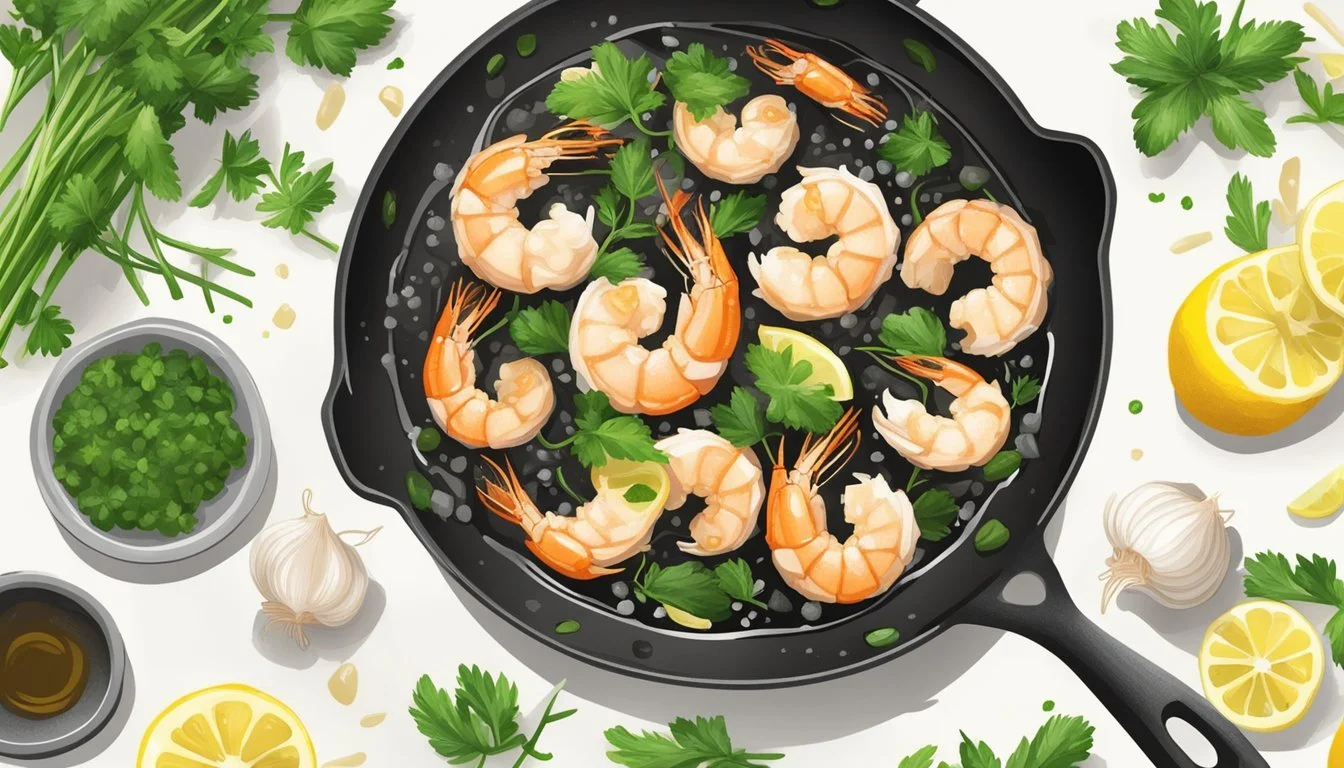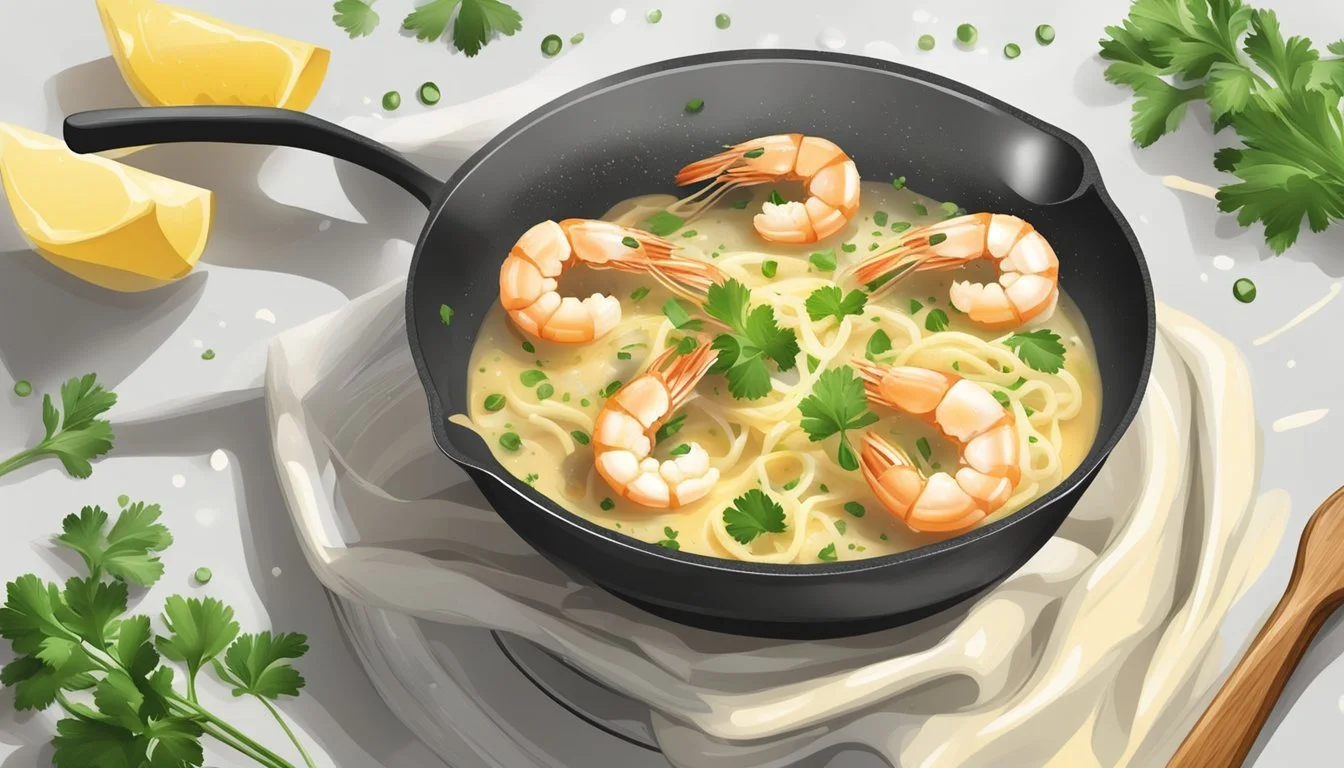Best Way to Reheat Garlic Shrimp Scampi for Perfect Succulence and Flavor Preservation
Garlic (What wine goes well with garlic?) shrimp scampi is a dish cherished for its rich flavors and tender texture. To maintain its delightful taste and succulence, reheating it properly is essential. The challenge lies in warming the shrimp to the perfect temperature without overcooking them, as they can quickly become tough and rubbery. Knowledgeable chefs agree that the key to preserving the delicate texture of garlic shrimp scampi during reheating is to use gentle heat and to protect the shrimp from direct, high heat.
There are several methods to reheat this seafood delicacy effectively. The oven is often preferred for its even distribution of heat. When using an oven, the shrimp should be arranged in a single layer on a baking sheet, ideally covered with foil to retain moisture, and heated at a moderate temperature of around 350°F. The stovetop method, on the other hand, involves reheating the shrimp in a skillet over medium heat, allowing for close monitoring to prevent overcooking. This method provides a quick way to bring the dish up to temperature, ensuring that the garlic and butter meld together without sacrificing the shrimp's texture.
Regardless of the chosen method, it is crucial to avoid high heat and to heat the shrimp just until they are warmed through. This ensures the shrimp remain juicy and tender, just as they were when first prepared. Patience and attention during the reheating process will yield the best results, allowing the garlic shrimp scampi to retain its succulent quality and enchanting flavors.
Understanding Shrimp Scampi
Shrimp scampi is more than just a popular seafood dish; it is an intricate balance of flavors and textures that demands careful attention during preparation and reheating to maintain its quality.
Components of Shrimp Scampi
Shrimp scampi traditionally consists of large, succulent shrimp cooked in a rich sauce made from garlic, butter, lemon juice, and often white wine. These core ingredients are essential and work together to create the dish's signature taste:
Shrimp: The star of the dish, which provides the protein and desirable texture.
Garlic: Integral for the aromatic profile.
Butter: Adds richness and carries the garlic flavor.
Lemon Juice: Brings a bright acidity that balances the buttery sauce.
White Wine: When included, it adds complexity and depth to the sauce.
Texture and Moisture Considerations
The texture of the shrimp in scampi is paramount; they should be tender and juicy, not rubbery or dry. Here’s what needs to be understood about texture and moisture:
Texture: It's influenced by the cooking time and method. Overcooking during reheating can make shrimp tough.
Moisture: Essential to avoid a dry dish. The sauce components, primarily butter and wine, help retain moisture during cooking and reheating.
The art of reheating shrimp scampi lies in preserving these qualities. The right reheating method will ensure the shrimp remain moist and tender, and the garlic-infused sauce continues to complement their delicate flavor without overpowering them.
Preparation for Reheating
Before reheating garlic shrimp scampi, one should ensure that the dish will return to a palatable temperature without losing its succulent texture. Proper preparation steps are critical to achieving the best results.
Initial Inspection and Sorting
Upon retrieving the leftovers, one should inspect the shrimp scampi to ensure there are no signs of spoilage. If any pieces look or smell off, they should be discarded. It's also important to sort through the shrimp and remove any that are excessively small or delicate, as they may overcook during reheating.
Portioning Leftovers
Portion Sizes: Divide the shrimp scampi into individual servings, which will heat more evenly and prevent unnecessary reheating of the entire portion.
Extra Sauce: If there’s extra sauce, reserve it; adding sauce during the reheating process can help maintain moisture and flavor.
Storing Leftovers Properly
In the Refrigerator:
Place portioned shrimp scampi in an airtight container.
Ensure a tight seal to prevent odors from infiltrating the dish.
In the Freezer:
Pack the shrimp scampi in a freezer bag with as much air removed as possible.
To thaw frozen shrimp scampi, transfer it to the refrigerator a day before reheating, allowing a gradual rise in temperature.
Choosing the right storage conditions is essential. Shrimp scampi in an airtight container can be kept in the refrigerator for up to three days. For longer storage, a freezer bag will suffice, but the dish should be consumed within a month to maintain quality. When it comes time to reheat, the shrimp scampi should be thawed properly if frozen, and all components should be at a uniform, safe temperature to ensure the best possible eating experience.
Reheating Methods Overview
The key to successfully reheating garlic shrimp scampi lies in preserving its succulent texture and flavors. Choosing the right method and carefully monitoring the internal temperature and heating times are crucial.
Oven Reheating
To reheat shrimp scampi in the oven, one should preheat the oven to 350°F. The shrimp should be spread out in a single layer on a baking sheet, ideally in a shallow dish, and covered with foil to retain moisture. Heating for 10-15 minutes is typically sufficient, but one should check the shrimp periodically to avoid overcooking. The aim is to reach an internal temperature of at least 165°F.
Stovetop Reheating
The stovetop method requires the shrimp to be placed in a skillet with a small amount of oil or butter. Shrimp scampi should be warmed over medium heat, allowing the shrimp to gradually absorb the flavors. A splash of water or broth can be added to enhance moisture. It's important to stir occasionally and heat until the shrimp reach a safe internal temperature, typically within 5-7 minutes.
Microwave Reheating
For a quicker option, the microwave can be used. Place the shrimp scampi in a microwave-safe dish, cover with a damp paper towel, and heat on high for 1-2 minutes. Watching closely to prevent the shrimp from getting rubbery is essential. This method is convenient but may result in less evenly reheated shrimp compared to the oven or stovetop methods.
Step-by-Step Reheating Instructions
When reheating garlic shrimp scampi, the key is to preserve its delicate texture while ensuring it is heated through. The following methods provide instructions for the oven, stovetop, and microwave, each tailored to maintain the succulence of the shrimp.
Oven Method
Preheat: Set your oven to 275°F to gently warm the scampi without overcooking it.
Prepare: Place the shrimp scampi in an oven-safe dish and cover it loosely with foil to promote even heating and retain moisture.
Reheat: Warm in the oven for about 10 minutes. Check to ensure it’s heated through but not dried out.
Stovetop Method
Heat Pan: Use a skillet or frying pan on medium-low heat to provide gentle reheating. Add a small amount of oil or butter to prevent sticking.
Reheat: Transfer the shrimp scampi into the pan. Stir gently and occasionally for even heating and cook for 3-5 minutes until just heated through.
Microwave Method
Prepare: Place the garlic shrimp scampi in a microwave-safe dish. Cover it with a microwave-safe lid or cling wrap, leaving a corner open to allow steam to escape.
Heat: Reheat on medium power in 30-second intervals, stirring in between to ensure even heating. Total time should not exceed 1-2 minutes to prevent the shrimp from becoming rubbery.
Avoiding Common Reheating Mistakes
When reheating garlic shrimp scampi, key factors such as avoiding overcooking, maintaining moisture, and ensuring even heat distribution are critical to preserve the dish’s texture and flavor.
Avoid Overcooking
Shrimp scampi can easily become tough and rubbery if overheated. To prevent this:
Use a microwave with a lower power setting, reheating for short intervals of 1-2 minutes and checking frequently.
If using a skillet or saucepan, keep the temperature low and monitor the dish carefully, removing it from heat as soon as it reaches an internal temperature of 165°F (74°C).
Maintaining Moisture
Retaining the succulent quality of shrimp scampi is essential. To maintain moisture:
In a microwave: Cover shrimp with a damp paper towel or use microwave-safe lids.
In an oven: Lightly sprinkle water over the shrimp and cover the dish with foil before heating at 350°F for 10-15 minutes.
Even Heat Distribution
Even warming maintains texture consistency and prevents cold spots. Achieving this includes:
Stirring the shrimp periodically when reheating in a saucepan or skillet.
Arranging shrimp in a single layer on a baking sheet or dish to ensure each piece heats thoroughly.
Enhancing Flavor Post-Reheating
After properly reheating garlic shrimp scampi, enhancing its flavor ensures that the dish is as appealing as when it was first prepared. This can involve the addition of fresh ingredients and thoughtful serving suggestions.
Addition of Fresh Ingredients
He or she may consider adding fresh ingredients to the reheated scampi to revitalize its flavor profile. A squeeze of lemon juice can add brightness, while a drizzle of olive oil can lend a fresh, fruity aspect to the dish. If the shrimp scampi is served with pasta, tossing the pasta with a bit more olive oil can prevent it from drying out and help it absorb the flavors of the scampi. Additionally, incorporating fresh chopped onions can impart a crisp texture and a pungent kick that complements the shrimp.
Serving Suggestions
Serving the reheated garlic shrimp scampi with the right accompaniments can greatly enhance its overall taste. Offering a side of crusty bread helps to soak up the flavorful scampi sauce. When serving with pasta, ensuring that the pasta is cooked to al dente texture will provide a pleasant mouthfeel that contrasts well with the succulent shrimp. For those wishing to add more depth, a splash of broth when reheating can enrich the flavors and maintain the dish's moisture.
Storing and Reusing Leftovers
Ensuring the quality of leftover shrimp scampi begins with proper storage and ends with creative reuse. Stored correctly, shrimp scampi can retain its succulent texture and flavor, making it a versatile ingredient for future meals.
Refrigeration and Freezing Tips
Refrigeration:
Storage Duration: Leftover shrimp scampi should be refrigerated within two hours of cooking to prevent bacterial growth. It can be stored in the refrigerator for up to three days for optimal freshness.
Airtight Containers: Place the shrimp scampi in an airtight container or resealable plastic bag to maintain moisture and prevent odor transfer.
Extra Sauce: If there’s extra sauce, keep it! It will help to keep the shrimp moist when reheating.
Freezing:
Freezing Method: One can freeze shrimp scampi, although it's best to do this with the sauce to avoid drying out the shrimp. Use it within three months for best quality.
Thawing Process: Thaw frozen shrimp scampi in the refrigerator overnight, not at room temperature, to ensure safety and flavor.
Creative Uses for Leftover Shrimp Scampi
New Dishes: Transform leftover shrimp scampi into a new meal such as a pasta toss, a filling for tacos, or as a protein addition to salads.
Ingredient Preparation: Consider removing shrimp from the sauce if using them in a recipe that requires dry heat like sautéing or grilling, to avoid overcooking. Then, simply use the extra sauce as a base for a quick pasta or rice dish.



